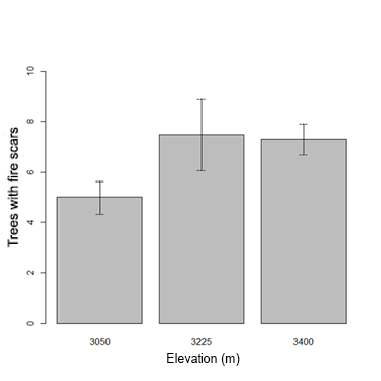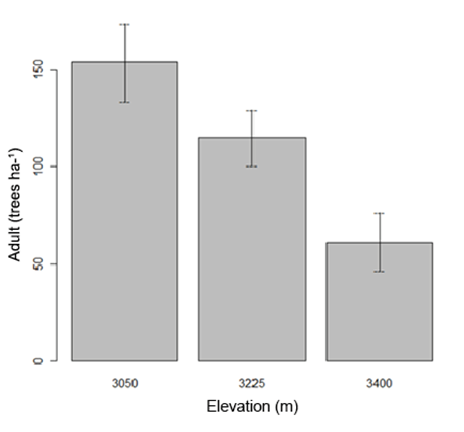Introduction
Regeneration is the way in which plants disperse and germinate in areas that have the right growth conditions (Baskin & Baskin, 1998). In an area affected by fire, germination and the establishment of seedlings depend on limiting factors such as water availability, temperature, light, density of seeds and predators (Baskin & Baskin, 1998). Many variables determine the frequency and intensity of forest fires, which, in turn, inhibit or promote the regeneration of conifers (Parro, Köster, Jogiste, & Vodde, 2009; Williams et al., 2013). Rising temperatures and droughts, after a fire, can inhibit the regeneration of some conifers and vary the composition and structure of the forest (Rother, Veblen, & Furman, 2015). In this context, Savage, Mast, and Feddema (2013) found that regeneration capacity decreases as periods of drought increase. It has also been reported that elevation and associated temperature affect plants regeneration in an important way (Chambers, Fornwalt, Malone, & Battaglia, 2016). On the other hand, because of the increase in temperature due to climate change, species are expected to migrate at higher elevations (Holtmeier & Broll, 2005).
In some regions and recent decades, fires have occurred more frequently (Williams et al., 2013). Fire affects the abundance of forest species and composition and structure of forests (Omi, 2005). Fire influences the age structure of tree populations and adult tree growth rings (Bosch, Giné, Ramadori, Bernat, & Gutiérrez, 1992).
In Mexico, the study of the effect of fires on pine regeneration is still underdeveloped. This study aims to contribute to the knowledge of the effect of altitudinal levels and fire regimes, for the conservation of Pinus hartwegii Lindl. natural areas on the highest mountain in northeastern Mexico. The mountain El Potosí is ideal for this study because of its altitudinal range and fire history. Pinus hartwegii presents fire adaptations, such as abundant post-fire regeneration, regrowth, protection due to its thick bark and foliage recovery (Rodríguez-Trejo & Fulé, 2003). The objectives of the study were to compare P. hartwegii regeneration and the number of trees with fire scars at different elevations; and determine whether regeneration is related to the density of adult trees and density of pine trees with fire evidence.
Materials and methods
Research area
This study was conducted in the mountain El Potosí, in the Sierra Madre Oriental, Nuevo Leon, Mexico. El Potosí is the highest mountain (1 800 to 3 660 m) in northeastern Mexico (Instituto Nacional de Estadística, Geografía e Informática [INEGI], 1986). The climates of the area are sub-humid and temperate sub-humid (García, Treviño-Garza, Cantú-Ayala, & González-Saldívar, 1999). The types of vegetation are temperate coniferous forest, mixed pine and oak forest, oak scrub, subalpine vegetation and alpine meadow at the top (García et al., 1999). The most common species are Pinus culminicola Andersen & Beaman, P. ayacahuite C. Ehrenb. ex Schltdl., P. hartwegii, Populus tremuloides Michcx, Abies vejari Mart. and Pseudotsuga menziesii (Mirbel) Franco (Aguirre-Calderón, Jiménez-Pérez, Kramer, & Akça, 2003). The distribution of P. hartwegii includes the gradient of 2 800 to 3 600 m, although it differs depending on the exposure, being narrower to the East (Aguirre-Calderón et al., 2003).
The fire has drastically affected vegetation in the study area. The last major fire occurred in 1998 (Ávila-Flores et al., 2014); subsequently, many mild forest fires have occurred. Those fires have left scars on tree trunks, which were used in this study as fire evidence.
Sampling
Sampling was conducted from April 2014 to May 2015. Five elevations in the range of species distribution were selected to determine the number of trees with fire evidence. Only stands larger than 400 m in length with less than 45° slope on the east side of El Potosí mountain were considered (walking on higher slopes requires special equipment). The size of the stands was defined regarding that they had at least 40 P. hartwegii adult trees. Only three elevations met the above criteria (3 050, 3 225 y 3 400 m). Stands were scarce and very small at 2 875 m. No specimens of the species were found at 3 575 m; a severe fire ended the populations of P. hartwegii and P. culminicola (Aguirre-Calderón et al., 2003). A total of five stands were selected at each of the three elevations. In each stand, 10 quarters were established centered on a point where P. hartwegii trees with a diameter at breast height (DBH) greater than 7.5 cm were measured. The point-centered quarter method consists of a series of points along a transect; each point represents the center of the imaginary quarter. The localized point is marked with a stake. Following the cardinal points, the area surrounding the sampling point is divided into four equal parts or quarters. In each quarter, we look for the tree closest to the central point (Cottam & Curtis, 1956; Mitchell, 2007).
A total of 200 trees were measured by elevation (600 in total), in which the distance from the tree to the central point, the number of trees with fire scars and the density of adult trees in the stand were determined. Regeneration was evaluated by establishing two square sampling sites of 75 m2 in each stand; that is, 10 sites per elevation. In each site, all small trees of P. hartwegii were measured, regarding the newly saplings and those with a diameter at breast height smaller than 7.5 cm. In each sapling, the number of whorls was determined to estimate the age (each whorl represents one year).
Data analysis
The response variables were tree density, density of trees with fire scars and density of saplings. Tests were carried out to determine the correlation between the number of burned trees and saplings, and between density of adult trees and saplings. In addition to that, analysis of variance were developed to determine differences in the number of trees burned and regeneration at different elevations. The data was analyzed using R 2.15.0 (R Development Core Team, 2010); normality tests were performed with Shapiro-Wilk and Kolmogorov-Smirnov, developing, in agreement, the Pearson correlation analyzes. The data that did not meet the normal distribution criteria were analyzed with Kruskal-Wallis.
Results and Discussion
The number of P. hartwegii trees with fire scars was similar between elevations (P = 0.051). There were 10 to 15 trees (25 and 37 %) with fire scars at each sampled point. Figure 1 shows that there was greater variability in the number of trees with fire scars at an altitude of 3 225 m, since the standard error is larger at 3 050 and 3 400 m.

Figure 1 Number of Pinus hartwegii trees with fire scars at three elevations sampled on the east side of the mountain El Potosí, Mexico. Means were statistically similar (F = 4.16, df = 28, P = 0.051). Standard error of the mean is represented on the bars.
Figure 2 shows that regeneration varied with the elevation (P < 0.001); more saplings were counted (3 000 individuals·ha-1) at the lowest elevation than at the largest (533 and 667 trees·ha-1). On the other hand, no correlation was observed between saplings and the number of trees with fire scars (r2 = 0.32, P > 0.05).

Figure 2 Density of saplings (diameter at breast height < 7.5 cm) of Pinus hartwegii at three elevation categories (Kruskal-Wallis, Chi-square = 14.82, df = 2, P < 0.001). Standard error of the mean is represented on the bars.
The regeneration of the population after fires can be affected by precipitation and temperature (Han, Shen, Ying, Li, & Chen, 2015). In the case of P. hartwegii communities, Rodríguez-Trejo (2001) indicated that light and moderate fires promote regeneration. This contrasts with the results, since no direct relationship was found between the evidence of low and medium intensity fires with regeneration. In post-fire regeneration studies, the density of Pinus ponderosa Douglas ex C. Lawson seedlings was higher near the line of surviving trees (Chambers et al., 2016). Christopoulou et al. (2014) also found greater regeneration of P. nigra Arnold near unburned areas. In our study, there was no regeneration of P. hartwegii or any other woody species in areas where trees survived the fire. Probably, soils burned after severe fires can be the cause of the absence of regeneration (Vacchiano et al., 2014).
With respect to adult trees, density was different among elevations (P = 0.002). Figure 3 shows that density was higher at lower altitude (3 050 m). The distribution of P. hartwegii in the mountain El Potosí has been considerably reduced; now, most remain in what was previously their intermediate elevation, with few trees at the lower elevation and none at the higher elevations. These results agree with the prediction that P. hartwegii can lose 80 % of its current distribution by the year 2050 (Gutiérrez & Trejo, 2014). In the case of other conifers, P. ponderosa regeneration is abundant at higher elevations (Chambers et al., 2016), compared to P. hartwegii. Petrie, Wildeman, Bradford, Hubbard, and Lauenroth (2016) found that P. ponderosa and P. contorta Douglas regeneration was greater in areas with temperatures between 20 and 25 °C, at the lower end of the species distribution. This contrasts with the results of Rother et al. (2015), who pointed out that P. ponderosa and P. menziesii regeneration was inhibited at lower elevations, due to drought and high temperatures attributed to global warming. Erickson, Nitschke, Coops, Cumming, and Stenhouse (2015) found a remarkable decrease in the right conditions for the regeneration of tree species in Alberta, Canada. In this study, P. hartwegii regeneration was greater at the lower elevation, so migration towards higher elevations may not occur, due to the potential decrease of germplasm and inadequate soil conditions caused by the fires.

Figure 3 Densities of adult trees (DBH > 7.5 cm) of Pinus hartwegii at three elevation categories. The densities differed among the three elevation categories (F = 7.55, df = 27, P = 0.002).
The density of adult trees and saplings were positively correlated (Figure 4) but with a high dispersion of data (r2= 0.43, P = 0.017). Most of the saplings found at the lowest elevation were less than 4 years old (Figure 5).

Figure 4 Density of adult trees and regeneration of Pinus hartwegii. Regeneration was higher when density of adult trees was higher (r2= 0.43, df = 27, P = 0.017).

Figure 5 Density of Pinus hartwegii saplings by age category at 3 050 m elevation (Kruskal-Wallis, Chi-cuadrada= 20.1, df = 5, P < 0.001). The age of regeneration was divided into categories by two-year segments to be compared with each other.
An abundant vegetation cover in areas with high tree density can contribute to regeneration (Kemp, Higuera, & Morgan, 2016), due to a delay in evaporation (Vacchiano et al., 2014). This coincides with the results of our study, since higher regeneration was found at sites with higher tree density. However, other authors have found greater survival after forest thinning (Man, Rice, & MacDonald, 2009). Perhaps this is relevant in high density stands and not in our study area, where natural vegetation is not very dense.
Conclusions
Regeneration of Pinus hartwegii showed no relationship with the fire evidence found. The number of trees with fire scars was similar at the sampled elevations. Density of saplings was higher at the lower elevation and in places with higher density of adult trees. This study contributes to the knowledge of the effect of altitude and fires in Pinus hartwegii regeneration in the northeast of Mexico.











 texto em
texto em 


